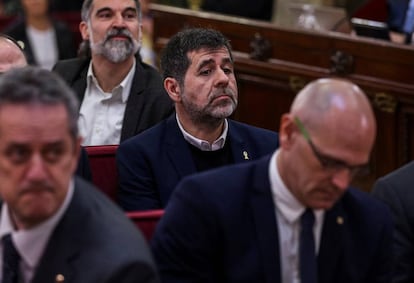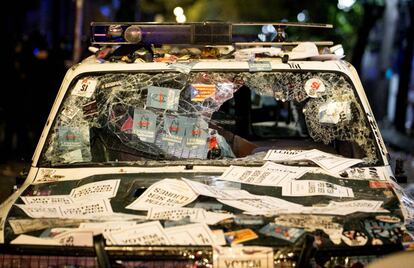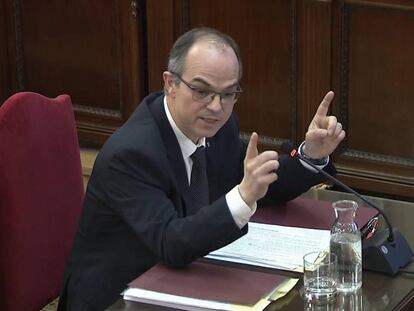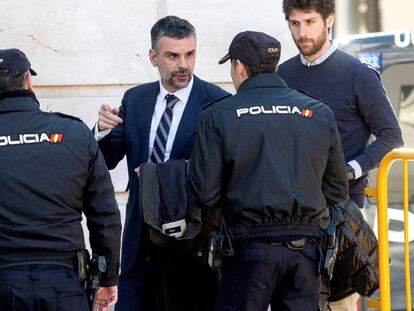Defendant in Catalan independence trial denies charges of rebellion
Former head of ANC civil association Jordi S¨¤nchez admits there were acts of violence during key protest outside Economic Affairs Department, but insists atmosphere was ¡°festive¡±


Day six of the Supreme Court trial against the pro-independence leaders involved in the 2017 secessionist drive in Catalonia saw testimony from Jordi S¨¤nchez, the former leader of the civil association ANC. The involvement of S¨¤nchez in a protest outside the regional Economic Affairs Department on September 20, 2017 is of key importance to the case, given that accusations of violence during that demonstration are integral to the charge of rebellion that several of the 12 defendants are facing.
S¨¤nchez admitted that there were ¡°moments of tension, some jeering at the police¡±
During questioning by the prosecution on Thursday, S¨¤nchez admitted that there had been acts of ¡°violence¡± on September 20, in particular the damage caused to several Civil Guard vehicles that were parked outside the building. But he rejected claims that they were the result of ¡°a continued assault¡± aimed at stopping the work of the Civil Guard. The authorities on that day were carrying out a series of raids aimed at seizing material being used to prepare the October 1 independence referendum, which had been declared illegal by Spain¡¯s top court.
According to the narrative presented by the public prosecutor in the Supreme Court on Thursday, the protest that was called on September 20 was designed ¡°to impede¡± the work of the Civil Guard, and the attendees did not hesitate to use violence to achieve their objective. For S¨¤nchez, however, the gathering was ¡°a protest¡± against the judicial operation, one that had greater success than was expected and that spun out of control of the organizers.

S¨¤nchez admitted that there were ¡°moments of tension, some jeering at the police,¡± but claimed that the overriding atmosphere was ¡°peaceful, festive.¡± According to his version of events, the demonstration started first thing in the morning when media reports emerged about the Civil Guard operation, and after calls to protest were put out via social media and radio interviews, the number of people who responded began to rise until as many as 50,000 demonstrators turned out.
¡°We never expected that,¡± S¨¤nchez told the court. ¡°When we decided to call [the protest] we requested authorization for the mobilization of 2,000 people.¡±
The defendant¡¯s account of the day included a number of conversations with the civil guard in charge of the security of the operation, as well as the regional interior chief Joaquim Forn (also accused of rebellion) and the head of the regional police force, the Mossos d¡¯Esquadra. According to his version of events, the authorities requested help to open up a corridor through which the judicial team could pass, and this was done.
As the protest began to grow, S¨¤nchez was also called on to get the demonstrators to move back 100 meters and clear the surroundings of the building. ¡°I told them that I was not able to do that,¡± he explained. ¡°That this was a public order issue and it wasn¡¯t my responsibility.¡± The ¡°protest¡± lasted well into the early hours of the next morning.
S¨¤nchez rejected claims about ¡°a continued assault¡± aimed at stopping the work of the Civil Guard
During Thursday¡¯s session, the public prosecutor spent a lot of time focusing on the ¡°serious damage¡± caused to the seven Civil Guard vehicles parked outside the Economic Affairs Department (S¨¤nchez claimed there were six). The destruction of these cars by the protestors is one of the keys to the accusations of sedition and rebellion faced by S¨¤nchez and Jordi Cuixart ¨C another defendant in the trial and the leader of ?mnium Cultural, a pro-independence association similar to the ANC ¨C given the alleged use of violence.
The images displayed during the trial showed the vehicles with the tires slashed, windows smashed and dents. S¨¤nchez recognized that this damage was done. ¡°I condemned this at the time, and I condemn it again today,¡± he said, but claimed that they were ¡°one-off¡± occurrences and did not reflect the full situation of the day.
The prosecutor questioned why S¨¤nchez had not called off the protest once it became clear that it had exceeded expectations and when he became aware of the damage to the vehicles. S¨¤nchez responded saying that he saw no reason to do so because the judicial team was still carrying out its raid. As he had agreed with the authorities, he and Cuixart called on the demonstrators to leave after midnight. They did so standing on top of one of the Civil Guard cars ¨C an image that was widely published in the media the next day. S¨¤nchez claimed on Thursday that they did so on instructions from the civil guard in charge of security on the scene. That claim will have to be backed up by the officer in question, who will appear as a witness later in the trial.
English version by Simon Hunter.
Tu suscripci¨®n se est¨¢ usando en otro dispositivo
?Quieres a?adir otro usuario a tu suscripci¨®n?
Si contin¨²as leyendo en este dispositivo, no se podr¨¢ leer en el otro.
FlechaTu suscripci¨®n se est¨¢ usando en otro dispositivo y solo puedes acceder a EL PA?S desde un dispositivo a la vez.
Si quieres compartir tu cuenta, cambia tu suscripci¨®n a la modalidad Premium, as¨ª podr¨¢s a?adir otro usuario. Cada uno acceder¨¢ con su propia cuenta de email, lo que os permitir¨¢ personalizar vuestra experiencia en EL PA?S.
En el caso de no saber qui¨¦n est¨¢ usando tu cuenta, te recomendamos cambiar tu contrase?a aqu¨ª.
Si decides continuar compartiendo tu cuenta, este mensaje se mostrar¨¢ en tu dispositivo y en el de la otra persona que est¨¢ usando tu cuenta de forma indefinida, afectando a tu experiencia de lectura. Puedes consultar aqu¨ª los t¨¦rminos y condiciones de la suscripci¨®n digital.










































